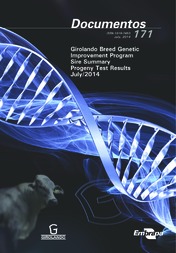Girolando breed genetic improvement program - Sire summary - Progeny test results - July/2014.
Girolando breed genetic improvement program - Sire summary - Progeny test results - July/2014.
Autoria: SILVA, M. V. G. B.; MARTINS, M. F.; PAIVA, L. DE C.; CEMBRANELLI, M. DE A. R.; ARBEX, W. A.; SANTOS, K. C. L. dos; PANETTO, J. C. do C.; CARVALHO, B. C. de; ALVES, B. R. C.
Resumo: The Girolando breed progeny test was established in 1997, as a result of the partnership between Girolando and Embrapa Dairy Cattle. In 2007, the Programa de Melhoramento Genético da Raça Girolando– PMGG (Genetic Improvement Program of the Girolando Breed) was implemented. Besides interacting with previously existing initiatives of the Girolando Breeders Association, such as the genealogical register service, the progeny test and the dairy control service, the PMGG launched the Linear Evaluation System (SLAG). The main objectives of the PMGG comprises identification of genetically superior individuals, the technically-oriented multiplication of genetics, the evaluation of economic traits and the promotion of sustainable dairy activities. The program have yielded impressive results. The Girolando breed semen sales increases faster than any other breed in Brazil. In 2013, over 544,000 semen doses were commercialized, implying an increment of 33.05% in comparison to 2012. It should also be stressed the remarkable increase in milk production of primiparous cows: in 2000 the production in 356 days was 3,657 Kg, while in 2013 it increased 19.4%, reaching a value of 4,534 kg. As a consequence of those and other factors, Girolando is achieving more recognition, nationally and internationally, and therefore, is being considered the preferable dairy breed in tropical regions. Because Girolando animals are capable to sustain an acceptable production level when raised in diverse types of management systems and environmental conditions, the breed is widely accepted in Brazilian dairy systems. In fact, 80% of the milk produced in the country originates from Girolando cows.
Ano de publicação: 2014
Tipo de publicação: Folhetos
Unidade: Embrapa Gado de Leite
Palavras-chave: Gado de leite, Melhoramento genético, Melhoria, Raça girolando
Observações
1 - Por padrão são exibidas publicações dos últimos 20 anos. Para encontrar publicações mais antigas, configure o filtro ano de publicação, colocando o ano a partir do qual você deseja encontrar publicações. O filtro está na coluna da esquerda na busca acima.
2 - Para ler algumas publicações da Embrapa (apenas as que estão em formato ePub), é necessário ter, no celular ou computador, um desses softwares gratuitos. Sistemas Android: Google Play Livros; IOS: iBooks; Windows e Linux: software Calibre.
Acesse outras publicações
Acesse a Base de Dados da Pesquisa Agropecuária (BDPA) para consultar o acervo completo das bibliotecas da Embrapa.

